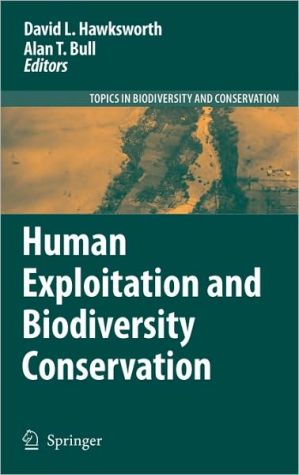

 |

|

Sold Out
Book Categories |
Impacts of demographic and socioeconomic factors on spatio-temporal dynamics of panda habitat; L. An et al.- Avian species richness and numbers in the built environment: can new housing develpments be good for birds?; C.F. Mason.- Indigenous knowledge and traditional conservation of fonio millet (Digitaria exilis, Digitaria iburua) in Togo; H. Adoukonou-Sagbadja et al.- People and mammals in Mexico: conservation conflicts at a national scale; L.-B. Vázquez, K.J. Gaston.- Urban domestic gardens (VI): environmental correlates of invertebrate species richness; R.M. Smith et al.- Biodiversity conservation in sacred groves of Manipur, northeast India: population structure and regeneration status of woody species; A.D. Khumbongmayum et al.- A numeric index to establish conservation priorities for medicinal plants in the Paravachasca Valley, Córdoba, Argentina; G.J. Martínez et al.- Subsistence hunting and conservation issues in the game reserve of Gile, Mozambique; A. Fusari, G.M. Carpaneto.- The catch and trade of seahorses in Vietnam; B.G. Giles et al.- Urban domestic gardens (VIII): environmental correlates of invertebrate abundance; R.M. Smith et al.- Effects of livestock grazing on aboveground insect communities in semi-arid grasslands of southeastern Arizona; S.J. Debano.- Medicinal plants of the Argentine Yungas plants of the Las Yungas biosphere reserve, northwest of Argentina, used in health care; N.I. Hilgert, G.E. Gil.- Hedges and green lanes: vegetation composition and structure; M.P. Walker et al.- Biodiversity and land use change on the Causse Méjan, France; E. O'Rourke.- Impact of game hunting by the Kayapó of south-eastern Arizona: implications for wildlife conservation in tropical forest indigenous reserves; C.A. Peres, H.S. Nascimento.- Genetic diversity in traditional Ethiopian highland maize accessions assessed by AFLP markers and morphological traits; Y. Beyene et al.- Towards a definition of a crop wild relative; N. Maxted et al.- Household differentiation and on-farm conservation of biodiversity by indigenous households in Xishuangbanna, China; F. Yongneng et al.- Convervation and documentation of the medicinal plant resources of India; R. Bhattacharyya et al.- Wildlife in the life of local people of the semi-arid Argentine Chaco; M. Altrichter.- An ethnobiological assessment of Rumohra adiantiformis (samambaia-preta) extractivism in southern Brazil; G. Coelho de Souza et al.- Urban areas and isolated remnants of natural habitats: an action proposal for botanical gardens; M.H.O. Pinheiro et al.- Impacts of community-based conservation on local communities in the Annapurna Conservation Area, Nepal; S.B. Bajracharya et al.- Stakeholder analysis of river restoration activity for eight years in a river channel; A. Tanaka.- Resolving the conflicts between biodiversity conservation and socioeconomic development in China: fuzzy clustering approach; Y. Lu et al.- The importance of stakeholder engagement in invasive species management: a cross-jurisdictional perspective in Ireland; K.E. Stokes et al.-
Login|Complaints|Blog|Games|Digital Media|Souls|Obituary|Contact Us|FAQ
CAN'T FIND WHAT YOU'RE LOOKING FOR? CLICK HERE!!! X
 You must be logged in to add to WishlistX
 This item is in your Wish ListX
 This item is in your CollectionHuman Exploitation and Biodiversity Conservation
X
 This Item is in Your InventoryHuman Exploitation and Biodiversity Conservation
X
 You must be logged in to review the productsX
 X
 X

Add Human Exploitation and Biodiversity Conservation, The sustainable use of biodiversity is one of the three key objectives of the 1992 Convention on Biological Diversity. To achieve this, sound conservation practice has to be recognized as beneficial and implemented by all who access, or use it—from subs, Human Exploitation and Biodiversity Conservation to the inventory that you are selling on WonderClubX
 X

Add Human Exploitation and Biodiversity Conservation, The sustainable use of biodiversity is one of the three key objectives of the 1992 Convention on Biological Diversity. To achieve this, sound conservation practice has to be recognized as beneficial and implemented by all who access, or use it—from subs, Human Exploitation and Biodiversity Conservation to your collection on WonderClub |